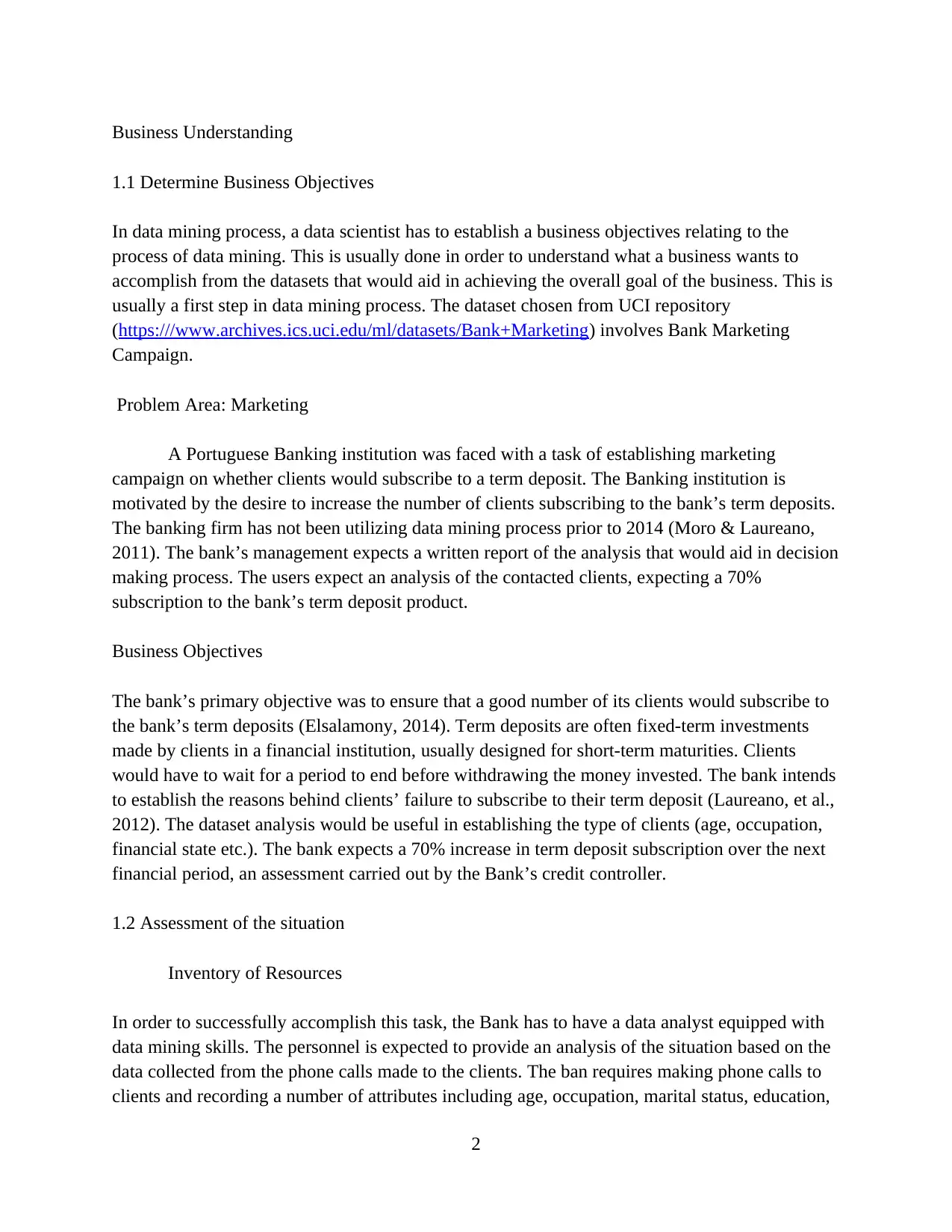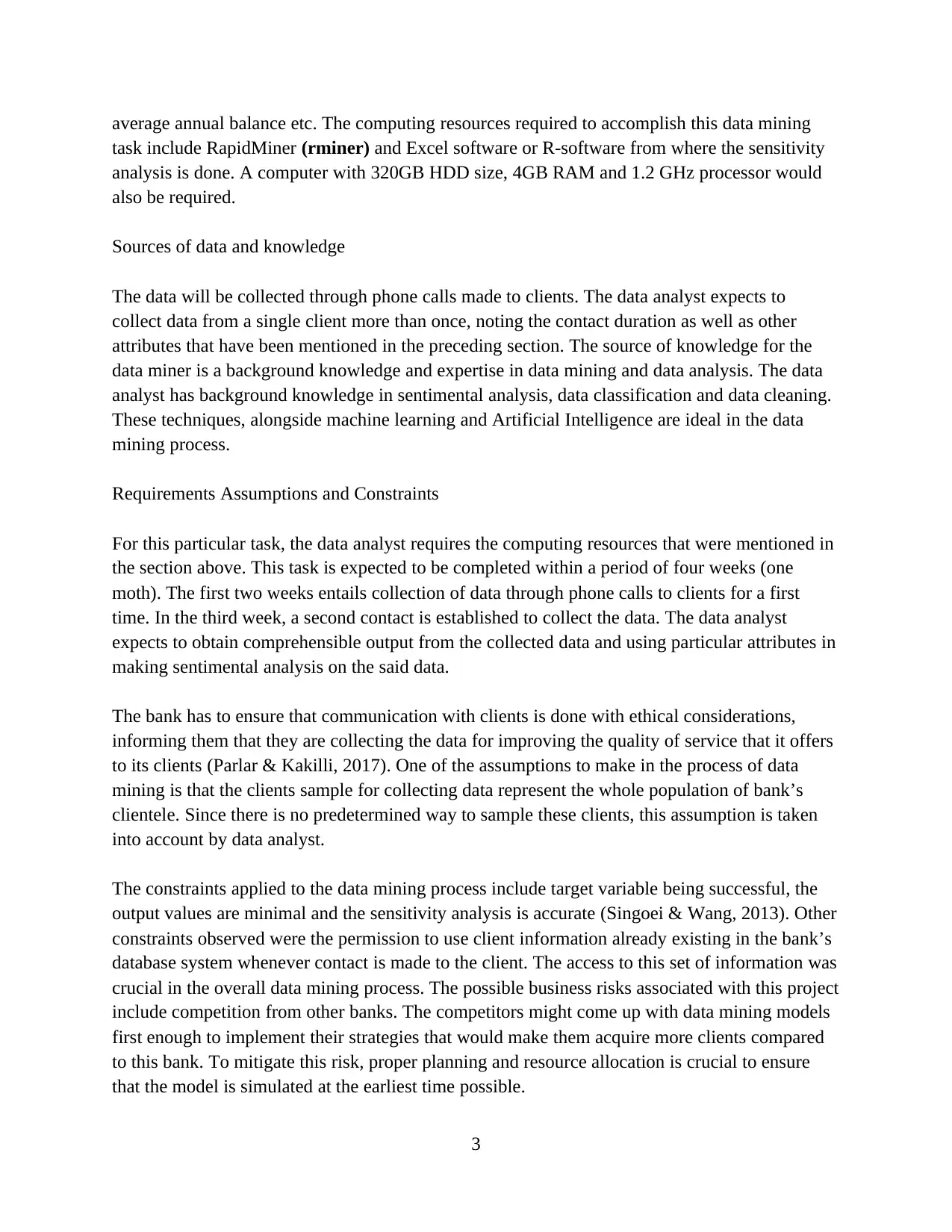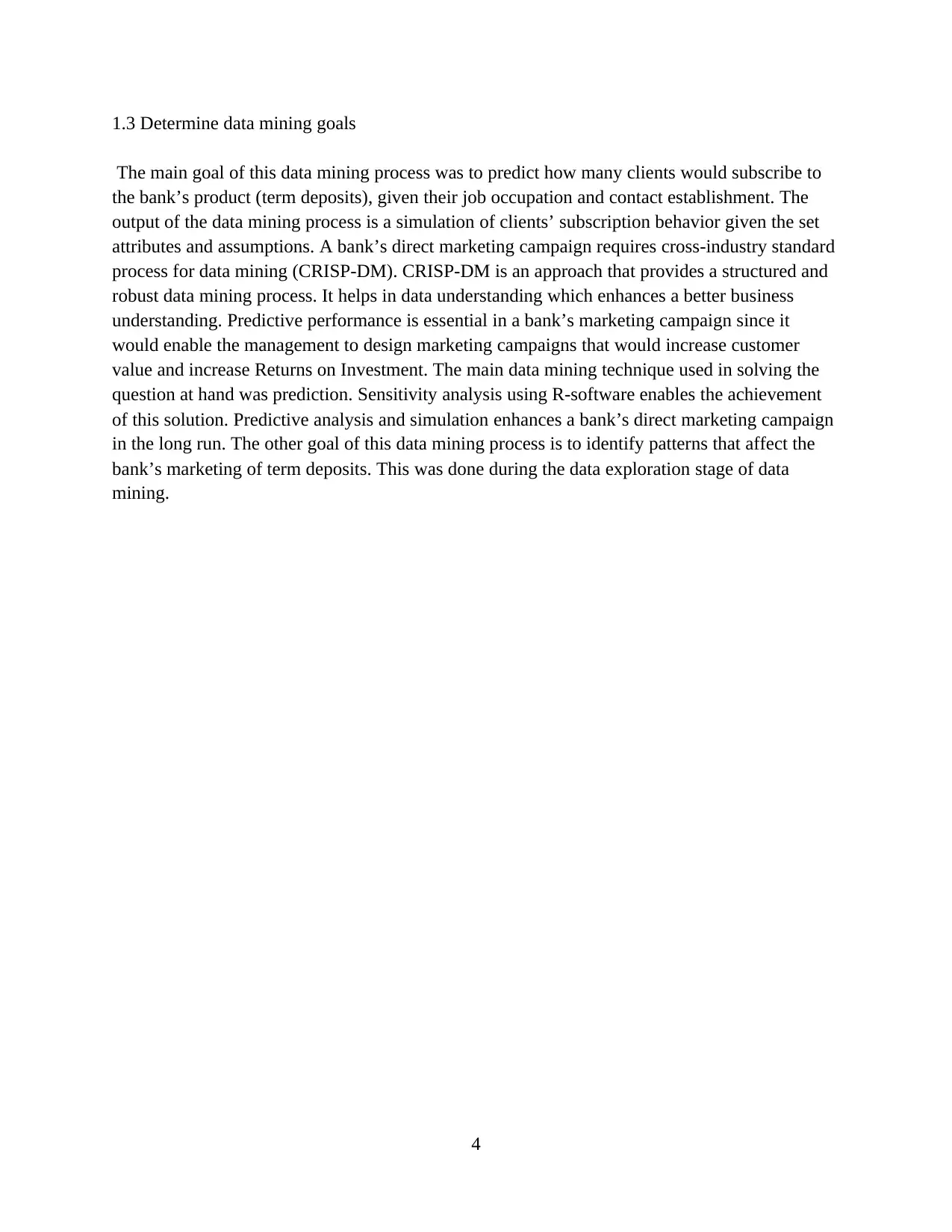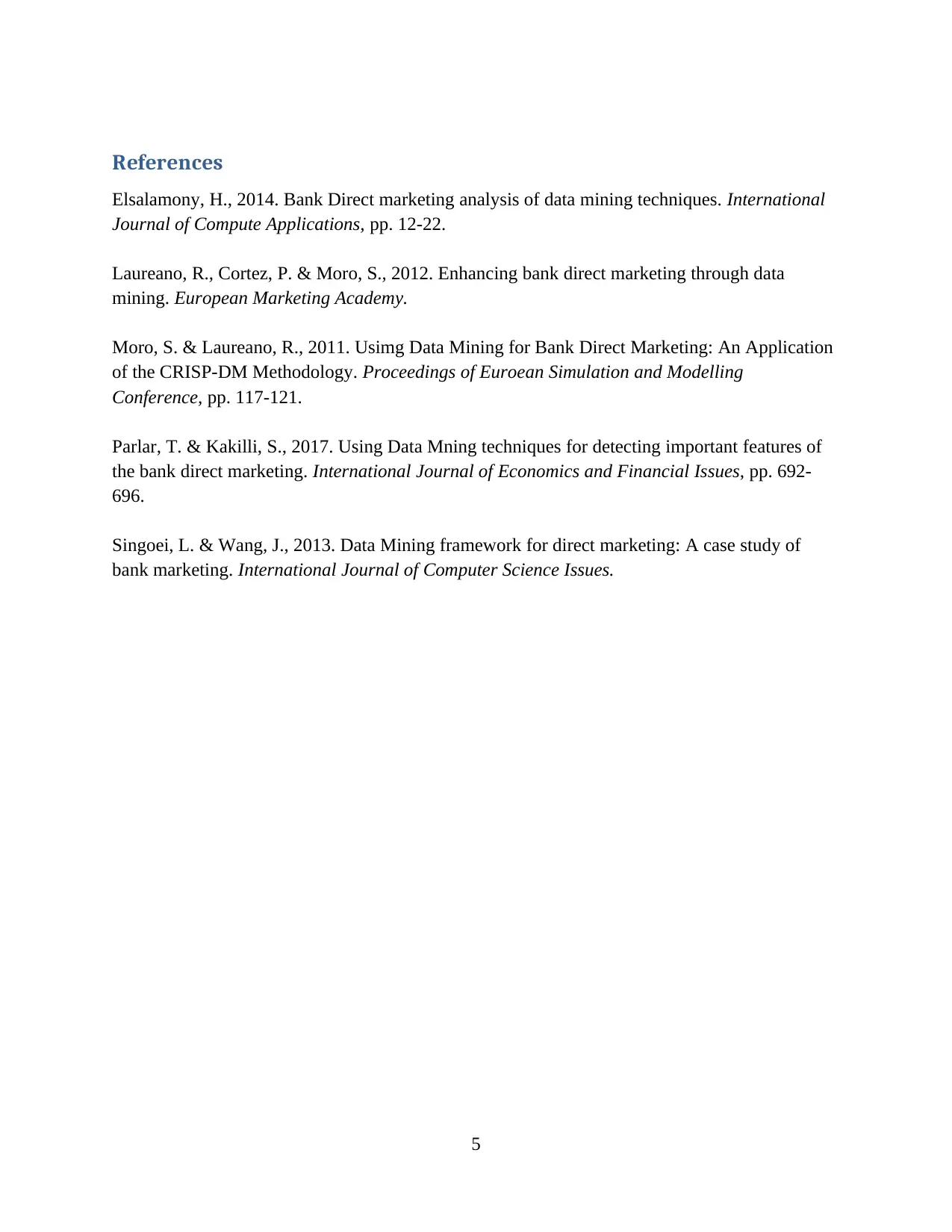Data Mining: Business Understanding Report on Bank Marketing Campaign
VerifiedAdded on 2022/09/26
|5
|1298
|25
Report
AI Summary
This report presents a data mining project focused on understanding business objectives within a bank marketing campaign. The assignment involves analyzing a dataset from the UCI repository related to a Portuguese banking institution's marketing campaign for term deposits. The report outlines the determination of business objectives, assessing the situation by inventorying resources, and defining data mining goals. It emphasizes the bank's desire to increase term deposit subscriptions and explores the use of data mining techniques, including sensitivity analysis with R-software and the CRISP-DM methodology, to predict client behavior and identify patterns influencing marketing effectiveness. The report also addresses the resources required, data sources, assumptions, constraints, and potential business risks, such as competition, along with mitigation strategies. The primary goal is to predict client subscription behavior and identify patterns, enhancing the bank's marketing campaigns and ROI.

Student’s Name:
Course Code:
Institution:
1
Course Code:
Institution:
1
Paraphrase This Document
Need a fresh take? Get an instant paraphrase of this document with our AI Paraphraser

Business Understanding
1.1 Determine Business Objectives
In data mining process, a data scientist has to establish a business objectives relating to the
process of data mining. This is usually done in order to understand what a business wants to
accomplish from the datasets that would aid in achieving the overall goal of the business. This is
usually a first step in data mining process. The dataset chosen from UCI repository
(https:///www.archives.ics.uci.edu/ml/datasets/Bank+Marketing) involves Bank Marketing
Campaign.
Problem Area: Marketing
A Portuguese Banking institution was faced with a task of establishing marketing
campaign on whether clients would subscribe to a term deposit. The Banking institution is
motivated by the desire to increase the number of clients subscribing to the bank’s term deposits.
The banking firm has not been utilizing data mining process prior to 2014 (Moro & Laureano,
2011). The bank’s management expects a written report of the analysis that would aid in decision
making process. The users expect an analysis of the contacted clients, expecting a 70%
subscription to the bank’s term deposit product.
Business Objectives
The bank’s primary objective was to ensure that a good number of its clients would subscribe to
the bank’s term deposits (Elsalamony, 2014). Term deposits are often fixed-term investments
made by clients in a financial institution, usually designed for short-term maturities. Clients
would have to wait for a period to end before withdrawing the money invested. The bank intends
to establish the reasons behind clients’ failure to subscribe to their term deposit (Laureano, et al.,
2012). The dataset analysis would be useful in establishing the type of clients (age, occupation,
financial state etc.). The bank expects a 70% increase in term deposit subscription over the next
financial period, an assessment carried out by the Bank’s credit controller.
1.2 Assessment of the situation
Inventory of Resources
In order to successfully accomplish this task, the Bank has to have a data analyst equipped with
data mining skills. The personnel is expected to provide an analysis of the situation based on the
data collected from the phone calls made to the clients. The ban requires making phone calls to
clients and recording a number of attributes including age, occupation, marital status, education,
2
1.1 Determine Business Objectives
In data mining process, a data scientist has to establish a business objectives relating to the
process of data mining. This is usually done in order to understand what a business wants to
accomplish from the datasets that would aid in achieving the overall goal of the business. This is
usually a first step in data mining process. The dataset chosen from UCI repository
(https:///www.archives.ics.uci.edu/ml/datasets/Bank+Marketing) involves Bank Marketing
Campaign.
Problem Area: Marketing
A Portuguese Banking institution was faced with a task of establishing marketing
campaign on whether clients would subscribe to a term deposit. The Banking institution is
motivated by the desire to increase the number of clients subscribing to the bank’s term deposits.
The banking firm has not been utilizing data mining process prior to 2014 (Moro & Laureano,
2011). The bank’s management expects a written report of the analysis that would aid in decision
making process. The users expect an analysis of the contacted clients, expecting a 70%
subscription to the bank’s term deposit product.
Business Objectives
The bank’s primary objective was to ensure that a good number of its clients would subscribe to
the bank’s term deposits (Elsalamony, 2014). Term deposits are often fixed-term investments
made by clients in a financial institution, usually designed for short-term maturities. Clients
would have to wait for a period to end before withdrawing the money invested. The bank intends
to establish the reasons behind clients’ failure to subscribe to their term deposit (Laureano, et al.,
2012). The dataset analysis would be useful in establishing the type of clients (age, occupation,
financial state etc.). The bank expects a 70% increase in term deposit subscription over the next
financial period, an assessment carried out by the Bank’s credit controller.
1.2 Assessment of the situation
Inventory of Resources
In order to successfully accomplish this task, the Bank has to have a data analyst equipped with
data mining skills. The personnel is expected to provide an analysis of the situation based on the
data collected from the phone calls made to the clients. The ban requires making phone calls to
clients and recording a number of attributes including age, occupation, marital status, education,
2

average annual balance etc. The computing resources required to accomplish this data mining
task include RapidMiner (rminer) and Excel software or R-software from where the sensitivity
analysis is done. A computer with 320GB HDD size, 4GB RAM and 1.2 GHz processor would
also be required.
Sources of data and knowledge
The data will be collected through phone calls made to clients. The data analyst expects to
collect data from a single client more than once, noting the contact duration as well as other
attributes that have been mentioned in the preceding section. The source of knowledge for the
data miner is a background knowledge and expertise in data mining and data analysis. The data
analyst has background knowledge in sentimental analysis, data classification and data cleaning.
These techniques, alongside machine learning and Artificial Intelligence are ideal in the data
mining process.
Requirements Assumptions and Constraints
For this particular task, the data analyst requires the computing resources that were mentioned in
the section above. This task is expected to be completed within a period of four weeks (one
moth). The first two weeks entails collection of data through phone calls to clients for a first
time. In the third week, a second contact is established to collect the data. The data analyst
expects to obtain comprehensible output from the collected data and using particular attributes in
making sentimental analysis on the said data.
The bank has to ensure that communication with clients is done with ethical considerations,
informing them that they are collecting the data for improving the quality of service that it offers
to its clients (Parlar & Kakilli, 2017). One of the assumptions to make in the process of data
mining is that the clients sample for collecting data represent the whole population of bank’s
clientele. Since there is no predetermined way to sample these clients, this assumption is taken
into account by data analyst.
The constraints applied to the data mining process include target variable being successful, the
output values are minimal and the sensitivity analysis is accurate (Singoei & Wang, 2013). Other
constraints observed were the permission to use client information already existing in the bank’s
database system whenever contact is made to the client. The access to this set of information was
crucial in the overall data mining process. The possible business risks associated with this project
include competition from other banks. The competitors might come up with data mining models
first enough to implement their strategies that would make them acquire more clients compared
to this bank. To mitigate this risk, proper planning and resource allocation is crucial to ensure
that the model is simulated at the earliest time possible.
3
task include RapidMiner (rminer) and Excel software or R-software from where the sensitivity
analysis is done. A computer with 320GB HDD size, 4GB RAM and 1.2 GHz processor would
also be required.
Sources of data and knowledge
The data will be collected through phone calls made to clients. The data analyst expects to
collect data from a single client more than once, noting the contact duration as well as other
attributes that have been mentioned in the preceding section. The source of knowledge for the
data miner is a background knowledge and expertise in data mining and data analysis. The data
analyst has background knowledge in sentimental analysis, data classification and data cleaning.
These techniques, alongside machine learning and Artificial Intelligence are ideal in the data
mining process.
Requirements Assumptions and Constraints
For this particular task, the data analyst requires the computing resources that were mentioned in
the section above. This task is expected to be completed within a period of four weeks (one
moth). The first two weeks entails collection of data through phone calls to clients for a first
time. In the third week, a second contact is established to collect the data. The data analyst
expects to obtain comprehensible output from the collected data and using particular attributes in
making sentimental analysis on the said data.
The bank has to ensure that communication with clients is done with ethical considerations,
informing them that they are collecting the data for improving the quality of service that it offers
to its clients (Parlar & Kakilli, 2017). One of the assumptions to make in the process of data
mining is that the clients sample for collecting data represent the whole population of bank’s
clientele. Since there is no predetermined way to sample these clients, this assumption is taken
into account by data analyst.
The constraints applied to the data mining process include target variable being successful, the
output values are minimal and the sensitivity analysis is accurate (Singoei & Wang, 2013). Other
constraints observed were the permission to use client information already existing in the bank’s
database system whenever contact is made to the client. The access to this set of information was
crucial in the overall data mining process. The possible business risks associated with this project
include competition from other banks. The competitors might come up with data mining models
first enough to implement their strategies that would make them acquire more clients compared
to this bank. To mitigate this risk, proper planning and resource allocation is crucial to ensure
that the model is simulated at the earliest time possible.
3
⊘ This is a preview!⊘
Do you want full access?
Subscribe today to unlock all pages.

Trusted by 1+ million students worldwide

1.3 Determine data mining goals
The main goal of this data mining process was to predict how many clients would subscribe to
the bank’s product (term deposits), given their job occupation and contact establishment. The
output of the data mining process is a simulation of clients’ subscription behavior given the set
attributes and assumptions. A bank’s direct marketing campaign requires cross-industry standard
process for data mining (CRISP-DM). CRISP-DM is an approach that provides a structured and
robust data mining process. It helps in data understanding which enhances a better business
understanding. Predictive performance is essential in a bank’s marketing campaign since it
would enable the management to design marketing campaigns that would increase customer
value and increase Returns on Investment. The main data mining technique used in solving the
question at hand was prediction. Sensitivity analysis using R-software enables the achievement
of this solution. Predictive analysis and simulation enhances a bank’s direct marketing campaign
in the long run. The other goal of this data mining process is to identify patterns that affect the
bank’s marketing of term deposits. This was done during the data exploration stage of data
mining.
4
The main goal of this data mining process was to predict how many clients would subscribe to
the bank’s product (term deposits), given their job occupation and contact establishment. The
output of the data mining process is a simulation of clients’ subscription behavior given the set
attributes and assumptions. A bank’s direct marketing campaign requires cross-industry standard
process for data mining (CRISP-DM). CRISP-DM is an approach that provides a structured and
robust data mining process. It helps in data understanding which enhances a better business
understanding. Predictive performance is essential in a bank’s marketing campaign since it
would enable the management to design marketing campaigns that would increase customer
value and increase Returns on Investment. The main data mining technique used in solving the
question at hand was prediction. Sensitivity analysis using R-software enables the achievement
of this solution. Predictive analysis and simulation enhances a bank’s direct marketing campaign
in the long run. The other goal of this data mining process is to identify patterns that affect the
bank’s marketing of term deposits. This was done during the data exploration stage of data
mining.
4
Paraphrase This Document
Need a fresh take? Get an instant paraphrase of this document with our AI Paraphraser

References
Elsalamony, H., 2014. Bank Direct marketing analysis of data mining techniques. International
Journal of Compute Applications, pp. 12-22.
Laureano, R., Cortez, P. & Moro, S., 2012. Enhancing bank direct marketing through data
mining. European Marketing Academy.
Moro, S. & Laureano, R., 2011. Usimg Data Mining for Bank Direct Marketing: An Application
of the CRISP-DM Methodology. Proceedings of Euroean Simulation and Modelling
Conference, pp. 117-121.
Parlar, T. & Kakilli, S., 2017. Using Data Mning techniques for detecting important features of
the bank direct marketing. International Journal of Economics and Financial Issues, pp. 692-
696.
Singoei, L. & Wang, J., 2013. Data Mining framework for direct marketing: A case study of
bank marketing. International Journal of Computer Science Issues.
5
Elsalamony, H., 2014. Bank Direct marketing analysis of data mining techniques. International
Journal of Compute Applications, pp. 12-22.
Laureano, R., Cortez, P. & Moro, S., 2012. Enhancing bank direct marketing through data
mining. European Marketing Academy.
Moro, S. & Laureano, R., 2011. Usimg Data Mining for Bank Direct Marketing: An Application
of the CRISP-DM Methodology. Proceedings of Euroean Simulation and Modelling
Conference, pp. 117-121.
Parlar, T. & Kakilli, S., 2017. Using Data Mning techniques for detecting important features of
the bank direct marketing. International Journal of Economics and Financial Issues, pp. 692-
696.
Singoei, L. & Wang, J., 2013. Data Mining framework for direct marketing: A case study of
bank marketing. International Journal of Computer Science Issues.
5
1 out of 5
Related Documents
Your All-in-One AI-Powered Toolkit for Academic Success.
+13062052269
info@desklib.com
Available 24*7 on WhatsApp / Email
![[object Object]](/_next/static/media/star-bottom.7253800d.svg)
Unlock your academic potential
Copyright © 2020–2025 A2Z Services. All Rights Reserved. Developed and managed by ZUCOL.





